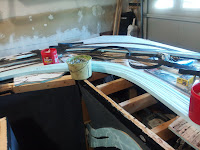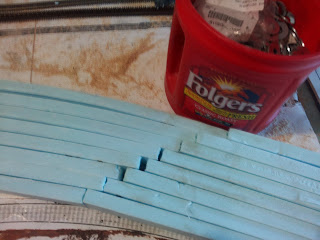First off...Kudos to the gang at Kalmbach for the May issue of Model Railroader. Not one but TWO whole articles that hardly even mention a manufacturer. Both articles were about scratch building structures. One was really oldschool, no plastic, no Grandt or Tichy window castings. Just plain old drawing board and, get this, INDEX CARDS.
OMG...It felt like I was reading MR from the the 1950's. Who'd a thought you could build anything out of plain old STUFF. Poster board walls, index card siding, balsa and basswood stiffeners. You can make everything, including doors and windows! Roof paper from painters tape, window mullions from more tape, home made window panes? Unbelievable!
Back to the subject...No I am not starting yet another helix, thank you very much. I'm good with the one I have (this time). No, it's just that something in my last missive stayed in my head and I should have heard the bells going off . "Now there was trouble" as they say in Thomas...
 |
| Sweeping Curve at Tunnel Hill |
I've gotten to know myself better in my golden years (must be the therapy) and could have told you as soon as I saw the curve in yon photo that I wouldn't stop there. I didn't. After chores this morning I took some splines and laid them out on the Eastern Slope...You know just to see what it might look like. Then I found myself pulling up Track 1, the only track that goes beyond BO (SLOPE). Next thing you know I'm pulling up ballast strip, then roadbed and finally, knocking out all the uprights that support the roadbed. I was gonna replace those anyway, right? So for the umpteenth time, I'm redoing the roadbed.
With all the "old" roadbed out of the way, I laid out the splines in earnest. Since I only cut 16 I borrowed from all the other areas and ran a 4 track set between BO and Kittanning Curve. That's 16' of roadbed and maybe halfway up The Hill...
 |
| New Spline Roadbed From BO... |
 |
| ...Around McGarveys... |
 |
| ...Through Wikes... |
 |
| ...To Kittanning |
The splines are just laid out for now, but I did start gluing up the spline for Track 1. I'm typing this while taking a break and letting the glue set...
 |
| Track 1 at BO Glued |
This time the spline is flat rather than cut to a slope. It's much easier to level out and glue up. One of the issues with cutting a grade into the spline was the "offset" that occurs because of curves...
 |
| Offset Joints |
Using flat splines requires a transition into the rest of the layout. That was easy enough to take care of. Since the roadbed at BO was already "cookie cut" all I had to do was match the grade in the two different types of construction. All I did was raise the cookie cutter roadbed to match the height of the splines.
 |
| Transition Joint |
I still have enough of the 4' x 8' foam sheet to make another 16 splines. That's enough for 16' of four track main. This should get me up to Tunnel Hill. The entire process goes quite quickly, although cutting the splines actually seems to take longer than using them.
There are several advantages to the styrosplines. The splines can be split anywhere the mains split and do so in a smooth curve. This is handy in places like Remington and Tunnel Hill where the eastbound and westbound tracks separate. It also makes it very easy to elevate one or more tracks above the others, as at Sugar Furnace where the westbound mains rise over the branch.
The foam is less susceptible to changes in moisture and temperature. It's rather inert as substances go. Each double spline set is the exact width of the ballast strip I use (Woodland Scenics?). 1 track requires 2 splines etc. I don't have to carefully cut any plywood to an exact width (yes, I do realize I've already done that). The flexibility of the foam makes for beautiful flowing curves with built in easements. The vertical thickness of each individual spline is stronger than you would think, and lamination makes them even stronger. The foam is standing edgewise and almost 2" thick.
So, if I tear up all the roadbed every time I think I have a better idea how on earth is this thing ever gonna get finished? I thought about that.
For one, I'd rather make changes while I'm building than wait until my "next" layout.to try new ideas. There may not be a "next".
Secondly...This is a hobby, something to pass the time. There is no rush.
Regards
Frank Musick
Chief Cook and Bottle Washer
 |
| Allegheny Eastern Railroad |

No comments:
Post a Comment